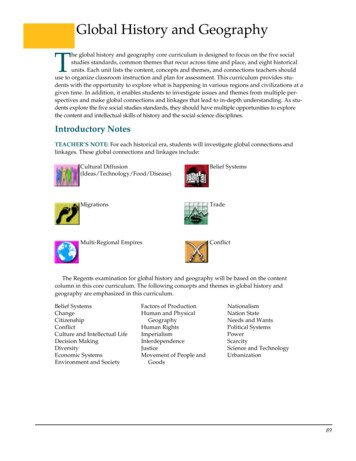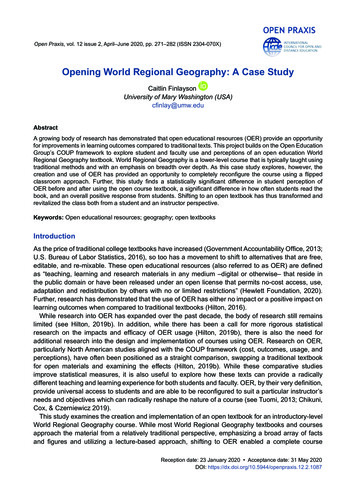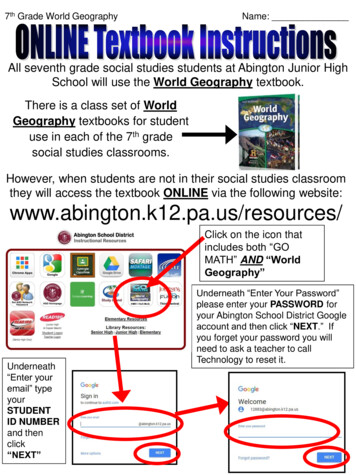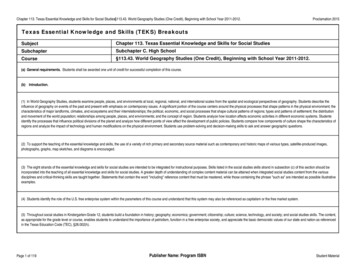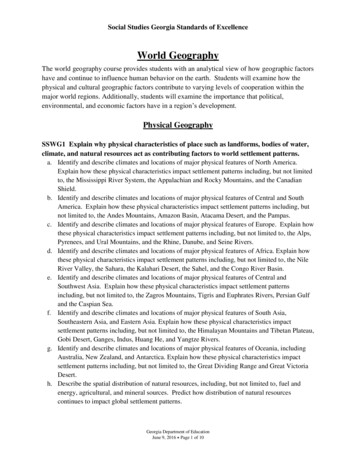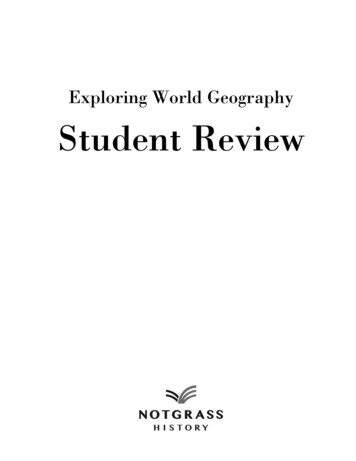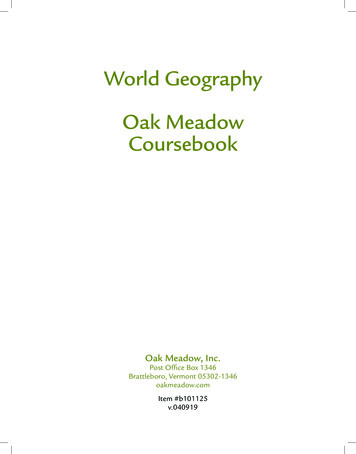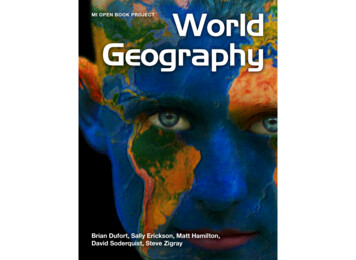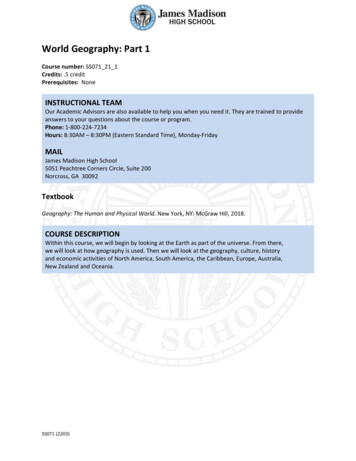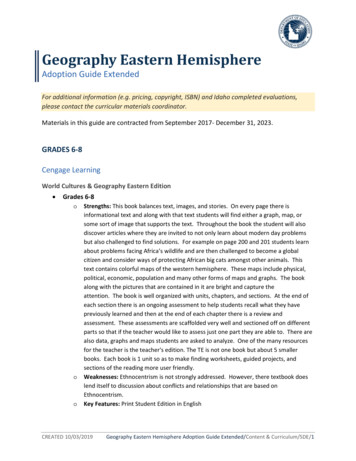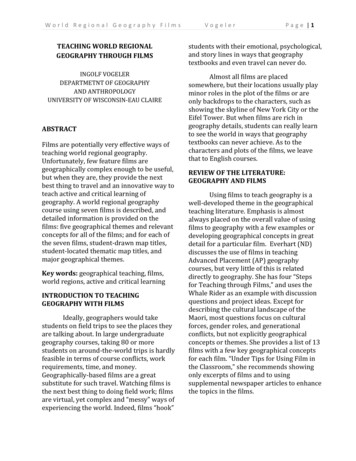
Transcription
World Regional Geography FilmsTEACHING WORLD REGIONALGEOGRAPHY THROUGH FILMSINGOLF VOGELERDEPARTMETNT OF GEOGRAPHYAND ANTHROPOLOGYUNIVERSITY OF WISCONSIN-EAU CLAIREABSTRACTFilms are potentially very effective ways ofteaching world regional geography.Unfortunately, few feature films aregeographically complex enough to be useful,but when they are, they provide the nextbest thing to travel and an innovative way toteach active and critical learning ofgeography. A world regional geographycourse using seven films is described, anddetailed information is provided on thefilms: five geographical themes and relevantconcepts for all of the films; and for each ofthe seven films, student-drawn map titles,student-located thematic map titles, andmajor geographical themes.Key words: geographical teaching, films,world regions, active and critical learningINTRODUCTION TO TEACHINGGEOGRAPHY WITH FILMSIdeally, geographers would takestudents on field trips to see the places theyare talking about. In large undergraduategeography courses, taking 80 or morestudents on around-the-world trips is hardlyfeasible in terms of course conflicts, workrequirements, time, and money.Geographically-based films are a greatsubstitute for such travel. Watching films isthe next best thing to doing field work; filmsare virtual, yet complex and “messy” ways ofexperiencing the world. Indeed, films “hook”VogelerPage 1students with their emotional, psychological,and story lines in ways that geographytextbooks and even travel can never do.Almost all films are placedsomewhere, but their locations usually playminor roles in the plot of the films or areonly backdrops to the characters, such asshowing the skyline of New York City or theEifel Tower. But when films are rich ingeography details, students can really learnto see the world in ways that geographytextbooks can never achieve. As to thecharacters and plots of the films, we leavethat to English courses.REVIEW OF THE LITERATURE:GEOGRAPHY AND FILMSUsing films to teach geography is awell-developed theme in the geographicalteaching literature. Emphasis is almostalways placed on the overall value of usingfilms to geography with a few examples ordeveloping geographical concepts in greatdetail for a particular film. Everhart (ND)discusses the use of films in teachingAdvanced Placement (AP) geographycourses, but very little of this is relateddirectly to geography. She has four “Stepsfor Teaching through Films,” and uses theWhale Rider as an example with discussionquestions and project ideas. Except fordescribing the cultural landscape of theMaori, most questions focus on culturalforces, gender roles, and generationalconflicts, but not explicitly geographicalconcepts or themes. She provides a list of 13films with a few key geographical conceptsfor each film. “Under Tips for Using Film inthe Classroom,” she recommends showingonly excerpts of films and to usingsupplemental newspaper articles to enhancethe topics in the films.
World Regional Geography FilmsLawhorn (2003) uses films to explorevarious regional and thematic topics butdoes not focus explicitly on geographicalconcepts. She uses films to teach geographyin her fifth grade curriculum. She definesgeography, lists 12 different sub-fields, andidentifies five themes of geography. Bothfeature and non-feature films are comparedand a very detailed lesson plan, includingspecific film titles, is outlined by scale, fromplanet earth to colonial New Haven.Orueta and Valdes (2007) talk aboutthree geographic ideas -- space, landscape,and territory -- as they relate to the makingof films in general, but no specific films arementioned. Tidd (2000) makes generalstatements about the value of using films inteaching in general and then recommendshis top 10 geography films. Engert andSpencer (2009) use films to teach aboutinternational politics.Algeo (2007) provides an excellentexample of how to use one film, Bend It LikeBeckham, in teaching cultural geography,but alas she only uses one film, which hardlyis sufficient in scope and depth for asemester long geography course. She arguesthat “classroom analysis of popular filmsencourages students to apply criticalthinking to everyday experiences, touncover ideologies embedded in their takenfor-granted world” (2007, 133). Sheemploys the concepts of ethnicity, migration,acculturation, assimilation, and socialconstruction of identity, all of whichunfortunately are not examined ingeographical or spatial terms. Except for onemap of the migration of Sikhs from India toEast Africa, Southeast Asia, and later to theUnited Kingdom, the application of herconcepts has more in common with postmodern analysis and cultural studies thangeography. Likewise, Alderman and Popke(2002) propose to use one film, MichaelVogelerPage 2Moore’s TV Nation, to learn about humorand geography.Aitken (1994) prefers to see filmsthan read books -- most undergraduateswould agree. In another article, Aitken(2003) uses several films set in Los Angelesthat deal with “difficult aspects of identity.”Maybe because this course was taught bythree faculty members from differentdisciplines and colleges, this article has nogeography in it. Even though words like“racial geographies,” “geography ofexclusion and betrayal,” “racist landscapes,”and “racial space” are cited, I find noevidence of actual geographical analysis, letalone maps and photographs, but onlyextensive narration of sociological topics.Call me old fashion, but this article is notabout teaching geography with films eventhough it deals with very important socioeconomic topics. Lukinbeal andZimmermann (2006) also explore fourfuture post-modern research topics for thesub-field of film geography by using the film,The Day After Tomorrow: geopolitics,cultural politics, globalization, and crisis ofrepresentation, realism, ideology, andpower. Despite the rhetoric, they providelittle actual geographical analysis andcontent.Di Palma (2009) goes so far as toassert that students must actually makefilms themselves with geographical contentbefore they can learn effectively. She reportson teaching secondary school students tomake their own films “to teach geography inan active way.” She realizes that films focuson characters and storyline, with thelocation and geographical settings being inthe background. She wants students to viewthe background as the foreground -- placinggeography at the heart of the learningexperience rather than as an incidentalaspect of the films viewing experience, and
World Regional Geography Filmsby extension, life itself. I would disagree thatviewing films is in and of itself a passivelearning mode; and only making films is acreative, active act. Films with complexgeographical themes demand attentive andcritical thinking that engage many skills, asdiscussed under Goals of the Course.WORLD REGIONAL GEOGRAPHYTHROUGH FILMS COURSEFor several years I have taught a geographyand film course as a special topics upperdivision course for geography majors inwhich I experimented with different filmsthat would be best suited for a geographycourse. Despite the vast selection of featureand non-feature films, and documentaries,very few films contain a variety ofgeographical themes, let alone deal withcomplex issues of scale, environment,history, race, ethnicity, politics, religion,gender, and class within geographicalcontexts. I have settled on seven full-lengthfeature films that are particularly rich andcomplex in physical and culturalgeographical themes set in a variety ofworld regions (Table 1). These seven films,with all the limitations that these films entailfor geographical scope, require students toapply their observational and analyticalabilities and skills to examining a wide rangeof films from many world regions.In this article I describe teaching ageography-films course for generaleducation (GE) credit to undergraduates. Ifind that a GE course has more benefits thana seminar for majors because non-majorsare exposed to geography in a more dynamicway. They get to discover and explore theworld of geography in the films they see,which are both challenging and rewarding,while still learning much of the geographicalcontent and many of the techniques that arenormally covered in traditional introductorygeography courses.VogelerPage 3GOALS OF THE COURSEActive learning is required whenviewing films and in applying relevantgeographical themes and concepts. Studentsmust take responsibility to learn geography.Faculty likewise need to be attentive andcreative in applying their geographicalexpertise to the films in the classroom andgrading.Students achieve the following tasksin this geography course:1. Observing films, in a careful, detailed,and thorough manner, for more than twohours;2. Note-taking, detailed and thorough -- analmost lost skill of undergraduates;3. Thinking about what they see in the filmsand how these relate to geography;4. Conceptualizing relevant geographicalcontents, ideas, and concepts as theyrelate to the films;5. Prioritizing geographical themes in thefilms for their projects;6. Applying geographical themes andconcepts to the films for their projects;7. Decision-making on what materialsshould be included in the final projects;Team work, learning to coordinate andcollaborate with different students;8. Creating various kinds of maps anddiagrams with appropriate software;9. Using presentation software (e.g.,PowerPoint), appropriately andeffectively;10. Referencing all materials, whether inprint or on the internet;11. Creating complete bibliographies -another much neglected skill ofundergraduates; and12. Producing seven projects, whichconstitute the course grade.
World Regional Geography FilmsVogelerPage 4Table 1 Course and alternative films with substantial and complex geographical contentCourse Films (Year): MinutesThe Field (1990): 113The Sheltering Sky (1990): 138Out of Africa (1985): 161A Passage to India (1984): 164Indochine (1992): 156The Mission (1994): 125El Norte (1983): 140Alternative Films (Year): MinutesThe Emigrants (1971): 191Central Station (1998): 106Motorcycle Diaries (2004): 126Emerald Forest (1985): 110Bride Flight (2008): 130The Piano (1993): 116Rabbit-Proof Fence (1992): 92STRUCTURE OF THE COURSEWorld Regions: CountriesWestern Europe: IrelandNorth Africa: MoroccoEast Africa: KenyaSouth Asia: IndiaSoutheast Asia: VietnamSouth America: Argentina & BrazilCentral & North America: Guatemala, Mexico, USAWorld Regions: CountriesNorth America: Midwest USASouth America: BrazilSouth America: Chile to VenezuelaSouth America: Brazil’s AmazonOceania: New ZealandOceania: New ZealandOceania: Australia’s OutbackThis geography course is taught over a15-week semester and meets only once aweek in order to show the films, most ofwhich are longer than two and half hourslong. If your university or college has thecapability of streaming films on-line, moreclassroom time can be used to discuss andrelate the geographical aspects of the films.Streaming lets students view the totality ofthe films, because there are no class timerestrictions. And they have the flexibilityand convenience of viewing films when andwhere they want on their own electronicdevices or in computer labs on campus.Students are assigned a world atlas and anintroductory world regional geographytextbook to use as references while theysearch for more detailed and variedinformation, maps, graphs, and photographson the internet for their projects. This kindof a geography film course has only beenpossible with the advent of the internet. Theenormous factual, visual, and cartographicmaterials on the web allow students tocompare multiple sources, decide on themost appropriate materials to be used fortheir projects, and then create complexgeographical responses in their finalprojects.The powerfulness of the internet forthis film course is illustrated by one examplefrom A Passage to India: many maps ofvarying quality and details are available onthe British control of India and the Indianindependent kingdoms. Students confrontthe complexity of original map materials andare forced to decide which maps suit theirpurposes best. They then have to locate andindicate (by means of colored shapes) wherethe film is set on the maps and relate thesethematic maps to the geographical themesand concepts in the film. Furthermore, whenusing computer software to draw their
World Regional Geography Filmsmaps, students have many map symbolsavailable on the internet which theyprobably would not be able to createthemselves (e.g., symbols for Hindu templesand Islamic mosques), resulting in attractiveand professional looking maps. These arechallenging tasks for all levels of students.At the very first introductorymeeting, we discuss the course structure,the films to be viewed, the format of thepreliminary and final projects, and thenature of geography. In the second weekclass, the first film is viewed (Table 1); inthe next weekly class, the film is discussedand preliminary student presentations aremade. In the third weekly class, the finalstudent team projects for the film previouslyviewed are due and another film is viewed.This cycle is repeated for each of the films.During the discussion classes, severalactivities are conducted:1. After the first geography-film projectshave been submitted, the previousweek’s preliminary film projects arereviewed by the faculty in class toprovide students with feedback so theycan learn individually and collectivelywhat they did well and what they need toimprove in their geographical analysis.Having students meet in a computer labgreatly enhances helping them improvetheir geographical thinking and projects.2. Faculty present mini-lectures ongeographical topics related to the filmwhich students saw in the previousweek. This assures for the relevantpresentation of geographical analysis.3. Faculty discuss with students what theythink is geographically interesting andimportant in the film which they viewedin the previous week.4. Four randomly selected students sharetheir preliminary presentations, usingVogelerPage 5PowerPoint, of the previous film with theclass. Faculty need to discuss andillustrate effective PowerPoint formats.Although students are familiar withwriting papers and getting evaluationson this form of communication andanalysis across most of the curriculum,almost all students are “visuallychallenged,” meaning that they have ahard time interpreting data, tables, andmaps -- they just done get enoughexposure. Geography is inherently morevisual than other disciplines, so teachingthis distinctive perspective creativelyand critical is crucial. For ideas on howto teach presentational spatial skills, seeEdward Tufte (2001, 1997, and 1990).Papers could, of course, be substitutedfor PowerPoint projects if faculty feel soinclined.5. Students critique these presentations asthey are being shown, and facultychallenge students to think innovativelyabout drawing maps and the range ofgeographical themes and concepts whichare applicable to the films. In theseclasses, students learn the strengthensand weaknesses of the film topics thatthey selected and the presentationalmaterial which they included to assurethat these are relevant and important tothe films.Students are provided with a list offive broad geographical themes: location,place, region, human-environmentalrelationships, and spatial movement (JointCommittee 1984), illustrated by Figure 1. Inaddition, a list of specific, detailed conceptsunder each broad theme are also provided(Table 2), which must be applied to each ofthe films as they are relevant. TheGeography Education Standards Project(1994) provides additional ideas andjustifications for specific geographical skillsDuring the discussion classes, various
World Regional Geography Filmsgeographical themes are considered andpreliminary presentations are made byabout four students. Students also selectFigure 1 Five broad geographical themespartners during the discussion classes. Twoperson final PowerPoint projects aresubmitted by the following week, beforeanother film is viewed. The final projects foreach film consist of four parts:1. Appropriate project titles, includingsome form of geography and the filmtitle, with appropriate geographicalphotographs.2. Locational maps, created and drawnby the students using a variety ofsoftware (e.g., PowerPoint, Paint,Abode Illustrator) and showingregional and site specific aspects foreach film. Map-making andcartographic skills are taught assemester-long courses in geographyprograms; hence, some of these skillsshould be taught in introductorycourses as well.VogelerPage 6To encourage decision-making,students select the map topics, details,and symbols and the appropriatesoftware on their own or with theirimmediate group member. Table 3provides a list of such student-drawnmap titles for each of the films. Anexample of such a map is the travelroute through North Africa based onThe Sheltering Sky (Figure 2).3. Geographical themes and concepts,consisting of mapped and un-mappedideas. These are researched by thestudents, largely from the internet.First, students find relevant thematicmaps on topics that relate to each ofthe films. Table 4 provides a list ofsuch map titles for each of the films.Second, these thematic maps mustshow the approximate location (if notexactly known) of where the filmstake place. Third, these thematic mapsmust also be justified and placed inthe context of major geographicalthemes in each of the films. Of course,not all geographical themes andconcepts can be mapped, but whenthey can, they should be. For example,this applies to many humanenvironmental concepts , yet theyshould, nevertheless, be included inthe projects and related to the films.Table 5 provides a list of major broadgeographical themes and specificconcepts in the seven films.Appropriate diagrams must also beincluded; see Figure 2 for examples.4. References, appropriately cited, for allmaterials used in the projects.
World Regional Geography FilmsVogelerPage 7Table 2 Broad geographical themes and concepts for all filmsLocationslongitude & latitudedistance: absolute & relativeRegionsuniform, nodal, & functional enationalism & cultural groupsPlacessite & situationlandscape: natural & culturalsequent occupancypopulation densityplace namesSpatial Movementsdiffusion: contagious & hierarchicalmigration: involuntary, chain, & returndispersal: centrifugal & centripetal forcestravel: personal & groupsHuman-Environmental Interactionsagriculture & foodplantations, family farms, & subsistencefarmingbuilding materialshouse stylessettlement patternsclimatic associationenvironmental symbolismenvironmental-cultural perceptionenvironmental determinismenvironmental acculturationenvironmental & cultural stereotypescultural adaption & maladaptationcolonialism & imperialismuneven developmentEurocentricismlocational & geographical racismTable 3 Student-drawn map titles based on the seven filmsThe FieldIrish villagefarm and surrounding countrysideThe Sheltering Skytravel route through North AfricaOut of Africatravel route from Denmark to KenyaBritish colonial towncoffee plantationA Passage to Indiatravel route from England to IndiaBritish colonial quarter in Indian citycountryside, mountains, & cavesIndochineFrench colonial cityrubber plantationtravel route through Vietnamkarst topography & coastlineThe MissionSpanish colonial townJesuit-Indian mission villagesEl Nortetravel route from Guatemala, Mexico to U.S.Spanish colonial townMexican border cityLos Angeles metropolitan area
World Regional Geography FilmsVogelerPage 8Figure 2 Types of diagrams and maps based on The Field, The Sheltering Sky, Out of Africa,and IndochineAll the films deal with thecomplexity of the concept of land, places,regions, landscapes, spatial movements,and environmental-cultural interactions.They raise intriguing and fundamentalhuman questions: 1) Does land ownership(by extension, wealth) belong to thosewho work the land or to those who ownthe land legally? 2) Why are some regionsand places perceived as exotic and erotic?3) Can humans, regardless of theirethnicity, class, and gender, ever “own”anything -- places, people, or evenrelationships? 4) Why do cultural groups,whether foreign or local, fight over landand places for natural resources, cultural,religious, and military reasons? 5) Whatconstitutes “home” in a geographicalsense, when do we ever know wherehome really is? Why are some peoplemore at home in “foreign” places than intheir country of birth and upbringing?The geographies in the seven filmsincluded here raise profoundly humanquestions, like life itself, unlike standardgeography textbooks which generallyavoid such inherently human andemotional predicaments.RESULTS FROM THE COURSEStudents present preliminary andfinal PowerPoint projects for each of theseven films. PowerPoint presentationsallow for visual presentation of text,maps, graphs, and photographs. Likewise,geography itself is a profoundly visualdiscipline in what it studies (what we seein the “real” world) and how it representsreality (in all manner of maps). Hence,geographical content in the films is
World Regional Geography FilmsVogelerPage 9Table 4 Student-located thematic map titles for the seven filmsThe Fieldoceanic climate in Western EuropeWestern highlands of Europepotato production regionsIrish famine regionsRoman Catholicism in Western EuropeBritish landowners concentrations inIrelandTinker community locationsThe Sheltering SkyFrench colonialism in North Africarailroad network in North AfricaAfricans cultural groups: Berbers &TuaregsIslam distributionsSahara desert: topography & climateOut of AfricaSavannah and wild life in East AfricaAfrican cultural groups: Kikuyu, Masai,SomaliBritish & German colonialism in EastAfricacoffee production regionsrailroad networkIslam & Sikhism distributions in EastAfricamalaria and syphilis spatial distributionsA Passage to IndiaBritish colonialism in South Asiaindependent Indian statesHinduism and Islam distributions in Indiarailroad networkmonsoons: temperature & rainfallelephants: wild & domesticatedpresented by the students in visual forms,rather than largely by words. Theseprojects are clearly challenging to thestudents, including seniors. There isnothing easy about them, as the goals ofIndochineFrench colonialism in Southeast Asiarubber production regionspaddy rice production regionsChinese imperialism in Southeast AsiaVietnamese nationalism & resistancepatternsBuddhism regionskarst topography & coastlineThe MissionSpanish & Portuguese colonialism in S.AmericaJesuit missions locationsRoman Catholic Church territorial disputesIndian cultural group: Guaranitropical rainforestsmountain riversEl NorteSpanish colonial towns in Latin AmericaGuatemalan Indian distributionsillegal immigrations routes in Mexico and U.S.Mexican border townsU.S.-Mexican international borderillegal apprehensions on U.S. border bylocationsLos Angeles barrio regionsinformal labor market locations in U.S.the course indicate.1) The integration of the content ofthe films with geographical ideas was onemajor issue, even after several classdiscussions. For example, for the first
World Regional Geography Filmsfilm, The Field, project titles consistedmostly of only the film title! By the secondfilm, The Sheltering Sky, project titlesmostly used geographical terms in thetitles but no reference to the film. Only bythe third film, Out of Africa, did moststudents finally use both the film’s titleand some aspect of geography in theirproject titles.2) Detailed and completeobservation and note-taking was anotherissue. Although most students took notesto construct locational maps, theycommonly left out several criticallandscape elements which wereimportant in the films and did not drawall the maps that were possible based onthe films.3) Many students had a hard timedeciding between major and minorgeographical themes. For example,although the British landlady and IrishAmerican businessman are critical to themeaning of what constitutes Irish landownership in The Field, several studentsinappropriately used two pages in theirfinal products to show maps of the USAand of the United Kingdom, includingnational flags and photographs of scenesunrelated to the film.4) Students were good at making listsof physical and cultural geographicalfeatures but they found it hard toconceptualize these into comprehensiveperspectives. Lists of descriptive words,often even inconsistent with the pagetitle, would be listed on unrelatedVogelerP a g e 10background photos, rather than withcreative diagrams or tables to synthesizethe details. For example, many studentsidentified different modes oftransportation (steamships, railroads,cars, bikes, camels, elephants) but onlyprovided photos and brief descriptionswithout relating these specifically to thefilms and the geographical contexts inwhich these modes of transportationwere used. Figures 2 provides examplesfrom four films of the kinds of diagramsand maps based on the films that studentsare expected to create.5) Aside from learning about majorworld regions, the most important goalsof the course are analytical skills andcritical thinking. Both skills are difficult toacquire for undergraduates and requirecontinual and repeated practice withincourses and across the curriculum. Byworking on seven PowerPoint projectsover the semester, students graduallylearn both.Over the course of the semester,students did learn from each project andimproved subsequent ones. Grading theseprojects makes it clear how slowlystudents learn and apply previous lessonsto subsequent work. The seven finalprojects provided the necessaryrepetition for students to achieve thegoals of the course.
World Regional Geography FilmsVogelerTable 5 Specific geographical themes in the seven filmsThe FieldBritish landlordsRoman CatholicismIrish tenantspotato faminesTinkers, landlessoceanic climateWestern Uplandsseaweed and bogsland & ownership: use value vs. market valueThe Sheltering SkyFrench colonialism in North Africacolonial railroads in North Africalocal people: Berbers & Tuareggender & place: exoticism & eroticismtourists vs. travelerstravel guidebooksSahara desertdesert climateoasis agriculture & townscaravans and salt tradeOut of AfricaBritish & German colonialism in East Africacolonial railroads in East Africacoffee plantationsAfrican tribes: Kikuyu, Masai, & SomalisEuropean settler empiretropical disease: malariaSavannah vegetationivory & big game trophy huntingsafari tourismownership: land, people, & relationshipsWorld War II conflicts in the coloniesA Passage to IndiaBritish colonialism in South Asiaindependent Indian kingdomscolonial cities & architecture: bungalowscolonial railroads: various gaugesHinduism & Islamindependence movements: Hinduism & Muslimcultural conflicts: religions, customs, & lawsgender & place: exoticism & eroticism“Eastern mysticism” vs. “Western rationality”monsoonstopographyP a g e 11IndochineFrench colonialism in Southeast AsiaFrench colonial citiesFrench rubber plantationsChinese merchants & mansionsVietnamese peasants & villagespaddy rice productionChristian missionary stations“forced” labor by French colonial governmentcultural conflicts: Western music, dance,clothing vs. Vietnamese theater, clothingconflict over land & people:French, Chinese, & Vietnameseindependence movements:nationalists & communiststropical climateskarst topography & coastlinesThe MissionSpanish & Portuguese colonialism in L. AmericaSpanish continental empireRoman Catholic Jesuit missionsslave trade in the AmericasIndian cultures: “civilized” & “primitive”geopolitics of the Roman Catholic Church:Treaties of Tordesillas (1494) & Madrid (1750)spatial repentance: journey of enduranceconflict over land & people in physical & culturalspacestropical rainforeststopography: water fallsEl NorteGuatemala:Spanish colonial planned townsMayan Indians distributionspolitical oppressions: military & paramilitarycivil war: 1954-1996 in the HighlandsMexico:border townsillegal immigration routesUnited States:border landscapesLos Angeles barriosimmigrant groups: legal & undocumentedspatial expressions: gender, class, work, & home
World Regional Geography FilmsCHALLENGES OF THE COURSEA film-based regional worldgeography course cannot cover as manytopics and concepts as regular textbooklecture-based courses, but what materialsare covered are more challenging (lessclear than textbooks) and rewarding(self-learning and discovery are betterretained) to both students and faculty.Discovery and exploration, the ultimateelements of geography, are put back intolearning. This kind of a course tradesvirtual experiential learning and discoverwith detailed geographical,cartographical, and presentational skillsagainst traditional formats which covermore regions with greater breath oftopics. Similar trade offs confront facultyand departments when they offer topicalversus regional-based world geographycourses. Each achieves what the otherdoes not and therefore is not suited for allfaculty. Whether teaching through filmsreally does a “better” job in installing instudents the geographical concepts andthemes germane to world regions (as onereviewer put it), all depends on what“better” is defined as. In this case, “better”refers to different goals than standardlecture-format courses which can thus notreally be compared to the course formats.This course requires considerableamount of work in the grading of sevenfinal projects, even if they are submittedby two-person teams. In my class of 40students, the 20 projects every two weeksrequired about five or more hours ofgrading and emailing my evaluativeresponses to the students. In addition toviewing the films, another five hours or soare required by the faculty to analyze thefilms for geographical content and toselect the appropriate concepts for classdiscussions. The more often this course is
introductory world regional geography textbook to use as references while they search for more detailed and varied information, maps, graphs, and photographs on the internet for their projects. This kind of a geography film course has only been possible with the advent of the
